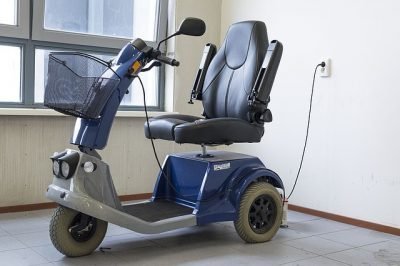
It’s not so much the idea of aging that scares us – it’s the loss of independence often associated with it. After all, what seems so very easy to us when we’re younger – something as simple as maneuvering the house from living-room to kitchen for a snack, or going down the road to the neighborhood department store – can become a potentially dangerous chore requiring tons of planning and risk-management when we’re afflicted with arthritis, multiple sclerosis or other conditions or disabilities resulting in a lack of mobility and coordination. Even in the best-case scenario where we have round-the-clock help, the idea that we’re unable to carry out the most simple of tasks without requiring someone’s help can affect us mentally, perpetuating the idea that we’re being a burden, often feeling helpless and reluctant to ask for help and winding up cooped inside a single room brooding on a solitary armchair.
It’s a desolate picture – but it doesn’t have to be. With the right mobility aid, we can not only move around the home, but also down the street, to the park and around a shopping mall, being as active and outgoing as we used to be without being held down or hindered by aching joints or a rapid onset of fatigue after a little exertion.

Specifically, we’re talking about mobility scooters. Something of a hybrid between motorbikes and wheelchairs, these scooters have turned over the lives not only of elderly experiencing a loss in mobility, but also those afflicted with movement-related disabilities or conditions which render walking for extended periods difficult and painful. Unlike wheelchairs (exempting motor-powered ones), you don’t need someone else to operate your mobility scooter – with a bike-handle style tiller, you get to steer the battery-operated scooter yourself, and, depending on the type of scooter you pick, be as flexible and free as you’d like when it comes to moving about your home or outdoors, going about life unimpeded.
So what should you look for in a good mobility scooter? Here’s our breakdown.
Portability
One of the best things about mobility scooters is their adaptability to public transport spaces. With compact and narrow models specifically designed for use aboard trains and buses, these scooters offer much better mobility than a manual wheelchair would – not only can you operate it by yourself, but they don’t take up all that much space. Looking out for public transport friendly models is a must if you plan on commuting significantly longer distances than is possible with a mobility scooter – even a roadster maxes out at 8 mph and isn’t suitable for highways, but the right scooter means you won’t have to be restricted in terms of where you can and cannot go.
Another factor in portability is if you can physically pack the scooter away to carry. Many models are foldable, or can be disassembled into smaller components, so they are much more car-trunk friendly than a large foldable wheelchair or a motorized, unfoldable wheelchair. This portability also means you can check them in when flying or travelling via train – you don’t have to rely on manual wheelchairs rented at the end destination this way, simply reassembling or unfolding your scooter and moving around freely once you’ve reached the stop.
Terrain

The type of space you’re going to use your scooter in determines what type of scooter you should be getting. Typically, three-wheeled scooters are better suited for the home and for indoor spaces like supermarkets and shopping malls. More effective on even terrain, the three wheels still give you the stability you need to move around in narrow or confined spaces without losing your balance or control over the vehicle, but do lack the maneuverability of making quick, sharp and complete turns. For a more maneuverable scooter, or one that will fare better on steep or uneven terrain, we recommend going for a four-wheeled scooter, with a climbing angle of at least 6 degrees, which works well in both indoor and outdoor spaces.
Typically, if you’re going to hit the road with your scooter, we recommend using a Class 3 mobility scooter, giving you better stability, sturdiness and speed suitable for the roads (not, however, freeways, highways or avenues of heavy and speeding traffic). Class 2 scooters are better for use on pavements and other even-terrain, low-vehicle traffic areas like shopping streets and centers.
Battery Life
Mobility scooters run on rechargeable batteries, and battery life determines how far you can actually travel with one. Not meant for long trips – long-range scooters generally let you travel about 30 miles, mid-range between 10-15 miles and short-range roughly 7-8 miles – the distance a scooter can travel is typically higher with higher ampere hours, and vice versa. Carrying an extra, fully-charged battery is recommended if you plan to use your scooter at a stretch or are unlikely to be stopping anywhere where you can recharge.
Batteries can both be in-built, with the unit as a whole plugged in for charging, or removable for external charging. Either way, it’s important to consult the manufacturer’s instructions on the optimum charging time, to make sure you don’t risk damaging the performance of your battery and unit. Batteries are either of sealed lead acid (SLA) or lithium variety – the distinction is important to be aware of if you’re planning to fly with your scooter, since although SLA batteries are non-spillage and sealed for travel-safety, lithium batteries need to be stored in a separate protective case. Airline policies for checked in mobility scooters may vary, so do your research beforehand to make the experience smoother for yourself.
Weight
Picking the right mobility scooter involves making allowances for your own weight as well as that of your scooter. If you pick too lightweight a scooter, or one that won’t be able to comfortably hold your weight, you risk destabilizing the unit.
Other features
You could tweak your scooter to suit your preferences with a couple of accessories and additional features. For instance, if you plan on using your scooter after dark, it makes sense to choose an option with headlights to ensure visibility. If you’re going to spend prolonged periods of time on your scooter, switching out for a comfier seat than the standard option your scooter comes with will help keep you comfortable as you go about your day.
Security features are also essential – key-lock mechanisms can ensure nobody can drive away with them when they’re parked, while scooters with alarms can notify you if someone attempts to make away with them in your absence.
What to remember when considering a mobility scooter
While mobility scooters can do wonders in terms of giving you freedom of movement when hampered by health or disability, they do still require a bit of upper body mobility and flexibility so you can steer and maneuver the scooter. If you find that you’re not as coordinated as you’d need to be to properly grip the handle-bars and steer, you might consider an option with tiller extensions to let you steer more securely – however, if you’re experiencing loss of mobility in your upper body, it’s advisable to look into options like motorized wheelchairs instead.
Although you won’t need a license for your scooter, it’s also crucial to remember that if you’re unfit to drive due to fading vision and hearing, or stilted reaction times, riding a scooter can be risky not just for yourself but for those around you as well.